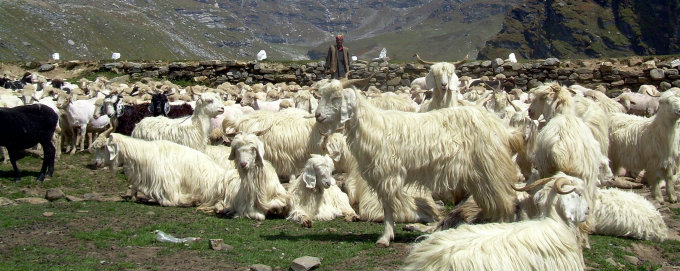Pashmina, Pashmina Scarves, Pashmina Shawls
The History of Pashmina Scarves and Shawls
Over the next few weeks we are going to be writing some posts on the history of Pashmina’s, Pashmina Goats who provide the beautiful wool for Pashmina’s and the Pashmina Industry.
This week we are starting with some history of Nepalese Pashmina’s and would like to acknowledge the Nepal Pashmina Industries Association (NPIA) as the source of some of the information. http://www.pashminaassociation.org.np/npia/home.php
We hope you enjoy learning more about where your wonderful Pashmina comes from.
The team at Pashmina Passion
“Pashmina” is the softest, beautifully delicate, weightless and the finest natural insulating fibre of the world. It is extracted from the inner coats of the hardy little mountain goats (capra hircus) locally called “Chyangra”, which live at the altitude above 3000 mtrs in the Himalaya Mountain regions of Nepal and north India.
These wonderful and gossamer properties of “Pashmina” have popularized it as the “Diamond Fibre”.
How is this Pashmina Wool produced?
The outer layer coat of the “Chyangra” are discarded as they are comparatively thicker & coarser. This leaves only the inner layer fibres which will measure under 16.5 microns as “Pashmina”. These extraordinary qualities of Pashmina fibres have encouraged weavers to produce various types of wraps for warmness for over 400 years.
The Fur combing process is performed once a year, every spring without harming the goats.
The Pashmina fibres are spun into thin yarn which is woven to make different types of pashmina products like blankets, shawls, stoles, scarves as well as pullovers, cardigans, etc. This exquisite craftsmanship of Nepalese weavers has established “Nepalese Pashmina” worldwide as the most precious possession. It takes the wool of 3 goats to make one 100% pure pashmina shawl.
In ancient times “Pashmina” was used in an unblended form but later it was combined with silk, cotton etc. After many years of experimenting, silk yarn was combined with the Pashmina yarn to get a stronger fibre strength and durability and sheen. Depending on preference Nepalese Pashmina yarn combined with 30%silk or less or used in its pure form have now become most popular all over world and recognized as “Nepalese Pashmina”.
History of Pashmina
The origin of Pashmina dates back to ancient civilization. Those days it was renowned as the ” Fibre for royals & emperors.” In Nepal also it has been traced back to the prehistoric times (or the time of Mahabharat). People living in the high mountains discovered the unique and wonderful properties of “Pashmina”. In more recent times the history of pashmina goes back to the days of Napoleon over 200 years ago when he presented a pashmina shawl to his wife. She was so pleased with the shawl that she asked Napoleon to get more so she could share them with her fashionable society friends. After, two hundred years of it’s popular history, pashmina remains an essential part of a fashionable wardrobe and popular wedding and bridesmaid gifts, attesting to the durability and widespread appeal of this classic accessory.
The Nepalese also learned to spin the fibres into fine yarn and then weave it to get an extraordinarily soft and warm fabric. This exquisite art of weaving was passed on from one generation to another and the art is still be carried on by these families
Nepal is famous for hand woven Pashmina products all over the world. They export mainly to Germany, France and Italy, USA, Brazil and Japan. Australia is a relatively new market.

